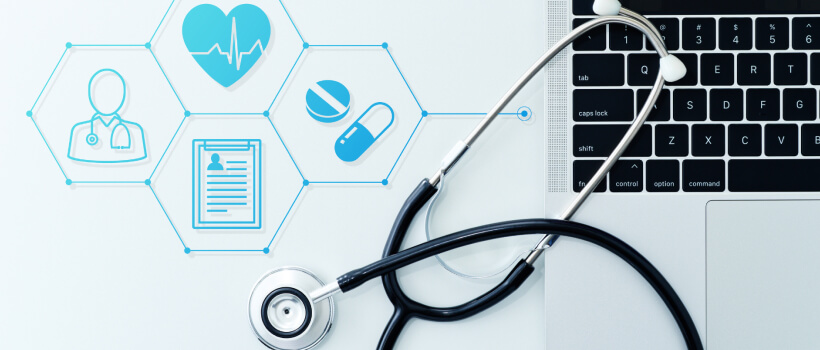 1-800-805-5783
1-800-805-5783 
The healthcare industry continues to experience remarkable advancements driven by the rapid evolution of technology. As we move into 2024 and beyond, the future of health tech holds even more significant potential for transforming patient care, enhancing accessibility, and reshaping the healthcare landscape. According to a recent report by Frost & Sullivan, the global healthcare IT market is expected to reach $552.8 billion by 2026, growing at a compound annual growth rate (CAGR) of 7.6% during the forecast period.
This article will explore the top trends and innovations in health tech poised to revolutionize healthcare in the coming years, bringing hope and optimism to healthcare professionals.
Big data continues revolutionizing healthcare in 2024, providing unprecedented capabilities for storing, processing, and analyzing vast amounts of patient data. This wealth of information holds immense potential to enhance healthcare outcomes through personalized treatment plans, real-time health monitoring, epidemic prediction, and cost reduction. According to the International Data Corporation (IDC), the Big Data analytics segment in healthcare is now valued at approximately $68.03 billion.
Healthcare providers increasingly utilize big data to leverage remote monitoring devices and applications, allowing continuous patient observation without frequent hospital visits. This approach improves patient convenience and enables early intervention and more proactive healthcare management. Moreover, advanced data analytics offer deeper insights, helping healthcare organizations make data-driven decisions, streamline operations, and optimize resource allocation to meet patient needs better.
In 2024, virtual reality (VR) technology continues to make significant strides in the healthcare industry, providing innovative medical training and treatment solutions. Medical professionals, from students to specialists, use VR more extensively to enhance their practical experience. With VR, they can simulate complex surgical procedures, reducing the risk of errors and improving preparedness for high-stakes operations. This immersive training allows healthcare workers to practice in safe, controlled environments before applying their skills in real-life scenarios.
Beyond training, VR has proven valuable in helping individuals with developmental disorders adapt to real-life situations and manage phobias. VR therapy programs, such as Psious, have been widely adopted by prestigious institutions across over 90 countries, offering effective adjuncts to traditional therapy. These programs assist individuals in overcoming fears, reducing anxiety, and practicing mindfulness techniques, all within immersive environments that enhance engagement and therapeutic outcomes.
Looking ahead, VR is playing an even more significant role in mental health treatment, offering more personalized and immersive therapeutic experiences. With the growing focus on mental health and the World Health Organization (WHO) highlighting the continued effects of misinformation on public health, VR is being leveraged to combat the “infodemic” by promoting accurate health education and debunking myths. As VR technology evolves, its potential in medical education and treatment continues to expand, transforming how healthcare is delivered globally.
In 2024, financial technology (FinTech) integration into healthcare systems is accelerating, providing powerful tools to streamline financial processes and reduce costs. As healthcare teams adopt FinTech solutions, they improve service delivery, gain real-time access to economic data, and boost operational efficiency. These innovations reshape how healthcare organizations manage financial workflows and interact with patients and insurers.
FinTech in healthcare now encompasses various services, including insurance management, digital payments, billing automation, capital-raising, and credit services. By leveraging these technologies, healthcare organizations can optimize payment plans, enhance financial management, and facilitate seamless data sharing with external stakeholders like insurance companies, improving overall transparency and coordination.
The healthcare industry’s adoption of peer-to-peer lending, mobile payments, and blockchain technology continues to gain traction. Blockchain, in particular, helps secure transactions and ensure data integrity, reduces the risk of fraud, and enables secure, efficient patient records and payment exchanges. These technologies improve transparency and security and speed up the payment process, benefitting healthcare providers and patients by making financial transactions smoother and more reliable.
FinTech integration in healthcare is poised to play a pivotal role in the industry’s future, offering new opportunities to enhance cost management, improve patient satisfaction, and foster innovation across financial processes.

In 2024, Remote Patient Monitoring (RPM) will continue to expand rapidly, becoming a core component of modern healthcare delivery. The pandemic has accelerated its growth and shows no signs of slowing. RPM systems enable healthcare providers to collect, analyze, and act on patient data without requiring in-person visits. This approach reduces the burden on hospitals and clinics while supporting more proactive and continuous healthcare management.
RPM systems typically involve wearable devices that monitor vital signs, activity levels, and other critical health metrics. These devices play a crucial role in managing chronic conditions such as diabetes, hypertension, and heart disease, providing real-time data that can alert healthcare professionals to potential issues before they become serious. In addition, they assist in medication adherence by sending reminders and enabling seamless data transmission to healthcare providers. As of 2024, over 30 million patients are using remote monitoring systems, with the global RPM market expected to surpass $1.7 billion.
The widespread adoption of RPM enhances patient care and addresses broader challenges in the healthcare system, including the growing nursing shortage. By allowing patients to stay connected with healthcare professionals remotely, wearable health devices reduce the strain on frontline clinicians, enhance workflow efficiency, and enable healthcare teams to focus on the most urgent cases. This technology is precious for managing aging populations and chronic diseases, supporting independent living while ensuring continuous care.
As RPM technology advances, it is increasingly integrated with AI-driven analytics, enabling healthcare providers to make more informed, data-driven decisions that improve patient outcomes and overall system efficiency.
In 2024, artificial intelligence (AI) has solidified its role as a transformative force in healthcare, significantly enhancing decision-making processes. AI-powered systems enable machines to analyze vast amounts of medical data, predict outcomes, and provide real-time support to clinicians. This technology is revolutionizing healthcare by making it more efficient, personalized, and accurate.
The global AI in healthcare market has continued its rapid growth, reaching new heights since its 2020 valuation of $6.7 billion. With a projected compound annual growth rate (CAGR) of 41.8% from 2021 to 2028, AI’s influence is expanding across various aspects of healthcare. By 2024, AI applications will not only support clinical decision-making. Still, they will also be widely used to predict patient responses to treatments, detect early signs of medical deterioration, and flag potential infections by analyzing remotely monitored vital signs.
One notable example of AI in action is the Ochsner Health System, which employs an AI tool to predict the likelihood of a patient experiencing cardiac or respiratory arrest. This system has enabled clinicians to intervene earlier, significantly improving patient outcomes. Such predictive analytics tools are becoming increasingly common in hospitals and clinics, helping to reduce medical errors, enhance patient safety, and streamline care delivery.
Telemedicine continues to redefine healthcare access, following exponential growth during the pandemic. What began as a necessity for remote care has now transformed into a cornerstone of modern healthcare delivery. Telemedicine has revolutionized how patients receive care by minimizing the need for in-person visits and offering convenient virtual consultations. While initially focused on acute care, telemedicine has expanded into chronic disease management, mental health services, and specialized fields such as cardiology and dermatology.
Telemedicine offers significant benefits, particularly for individuals in remote or underserved areas with limited access to healthcare services. Patients with chronic conditions, such as diabetes and hypertension, can now receive continuous care through remote monitoring devices and regular virtual check-ins with their healthcare providers. This approach improves long-term patient outcomes, reduces hospital readmissions, and lowers healthcare costs by preventing unnecessary emergency room visits.
Major corporations have also recognized telemedicine’s potential. Best Buy and Amazon, for example, have made strategic acquisitions and investments in telehealth platforms to expand their healthcare offerings. Best Buy acquired Current Health, a company specializing in remote patient monitoring, while Amazon launched Amazon Clinic, which offers virtual consultations and prescription services. These developments indicate the growing importance of telemedicine in the broader healthcare ecosystem.
In 2024, telemedicine will also address critical mental health needs, providing patients with convenient access to therapy and counseling services. As mental health concerns rise globally, virtual platforms are ensuring that individuals receive timely and personalized care regardless of geographical barriers.
Telemedicine is poised to be more significant in delivering accessible, cost-effective, patient-centered care. With advancements in AI-powered diagnostics, wearable health tech, and improved broadband access in rural areas, telemedicine is expanding its reach and scope. The combination of AI and telemedicine enables healthcare providers to analyze patient data in real time, offering more accurate diagnoses and personalized treatment plans during virtual consultations.
In 2024, the future of health tech holds immense promise for revolutionizing healthcare delivery, improving patient outcomes, and expanding accessibility. The healthcare industry is on the cusp of significant advancements driven by big data analytics, virtual reality (VR), AI, FinTech solutions, and remote patient monitoring (RPM).
Technological innovations like artificial intelligence (AI) and telemedicine are at the forefront of this transformation. AI-powered predictive analytics is helping healthcare providers anticipate health trends, detect diseases early, and personalize treatments based on individual patient data. At the same time, telemedicine is redefining access to healthcare by enabling virtual consultations, particularly for underserved populations, and improving care continuity for patients with chronic conditions.
The opportunities in health tech are vast, and the future is now. According to a recent report by McKinsey & Company, the global healthcare market is expected to reach $10 trillion by 2025, driven by factors such as an aging population, rising healthcare costs, and increasing demand for personalized care.
Healthcare organizations that harness the power of technology today will be better equipped to create a future where equitable, high-quality healthcare is accessible to all, regardless of geographic or socioeconomic barriers. The healthcare industry is at the threshold of a tech-driven revolution, and 2024 marks a pivotal moment in shaping the future of global healthcare.